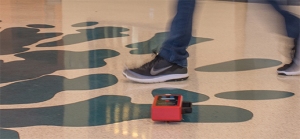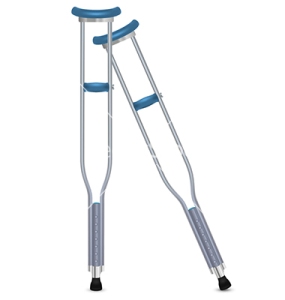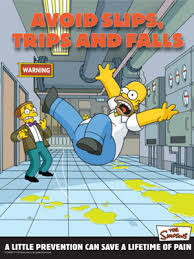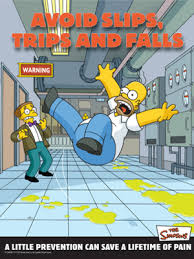Liability, Friction and Floors: Who’s to blame when someone falls?
*Nano-Grip treated floors assure compliance
Reprinted from the Nov. 20 issue of SERVICES, a building service industry trade magazine
Several years ago, a cleaning contractor in northern California was thrown on the hot seat before he even knew exactly what had happened. His company cleaned several branches of a major California bank as well as one of their offices. One afternoon, someone from the bank’s headquarters called him and asked him a series of questions such as, when was the last time his company had stripped and refinished the floors in the office location; what type of finish was applied; did he still have any gallons of the finish left and if not, could he verify when and where they were purchased; when was the last time his crew damp mopped the floors, and what type of cleaning solution was used.
The questions came fast and furious.Finally, he asked what this was all about.Now comes the explanation: a female employee, who was pregnant, slipped and fell on the floor. Although she said she was fine, the bank called an ambulance to ensure this was so. Apparently, what this bank representative was doing, whether right or wrong, was trying to place the blame for the accident squarely on the contract cleaner.
For building service contractors and facility managers this is a wake-up call. Invariably, if there is a slip and fall accident in a facility you clean and maintain, the blame will be shared between both parties in some way. And with new regulations coming, as we shall discuss later, it is imperative that you document how you clean and maintain your customers’ floors and have acceptable proof that they are safe to walk on.
This cleaning contractor was not prepared in any way for this incident. He did not even know what type of finish was applied to the floor or where he had purchased it.
However, in this case he was in luck.Thankfully she was not injured.The female employee who suffered the slip and fall was not wearing shoes. In fact, she had a tendency to take off her shoes and walk around the office in her socks and had actually been recently reprimanded for this behavior. Nonetheless, the bank, it appears, was fully prepared to have the contract cleaner take the blame for the incident and bear financial responsibility for any costs or lawsuits that might result; that is, until they realized all the circumstances of the event. . . and their case essentially evaporated The world of slip and fall is changing
Cleaning contractors need not only document their floor care cleaning and maintenance products as well as their procedures, but they also need to be aware of some rather big changes that OSHA* is implementing regarding floor care. This is happening even though they have not actually been approved by the organization. Possibly this is best explained using the following example. One day, OSHA conducted what can be termed a raid on one hundred locations of a national fast food franchise. The inspectors were not concerned about anything in the kitchen or food safety. What they were concerned about were the floors.
Under what is called the ‘general duty clause’ which is designed to protect, among other things, the safety of the customers, the OSHA inspectors tested all the floors for slip-resistance, determined many were ‘high-risk,’ and fined each location about fifteen hundred dollars.
According to Russell Kendzior, president of the National Floor Safety Institute, which creates standards to help ensure floors are safe, this fast food restaurant chain was likely a target.
“It’s almost like they were punishing this [fast food] chain. They likely assumed they were taking adequate precautions to ensure the safety of their floors and were totally unprepared or even expected this event.”
The fines, the inspection, and the increased awareness is part of OSHA’s goal to prevent a slip and fall accident from happening in the first place. Typically, floor friction and safety inspections are taken after an incident occurs and used in court to build a case against a company whose floors are suspected to be unsafe. But, by OSHA requiring employers and property owners to be proactive regarding their floor safety through making periodic measurements regarding coefficient friction, the goal is to dramatically decrease slip and fall incidents, and the lawsuits that often accompany them.
While the goal is well-intentioned, according to Kendzior, there are many concerns that must be addressed. First and foremost:
- Few companies, including building service contractors,are aware of the fact that OSHA is now inspecting floors for safety, even if no accident has been reported.
- Few organizations, as a result, including cleaning contractors, are prepared for this program.
- The program is being instituted even though it has not actually been published by OSHA.
- There are no clear standards yet as to what defines a safe floor and what constitutes a slippery floor.
“I’m also a little concerned about how this program will be implemented,” says Kendzior. “Will certain organizations be targeted, possibly like this fast food chain, or will the floor safety inspections be randomly selected or based on floor safety issues in different types of facilities. It’s all a bit fuzzy now how OSHA plans to carry out these inspections and who will be inspected.”
Proving floor safety
For building service contractors, OSHA’s actions are both a concern and an opportunity. They are a concern because BSCs must now take steps to ensure their customers’ floors are safe, and this is an opportunity for because the new law may open more doors, helping contractors secure new clients.
According to Craig Stephenson, vice president at American Slip Meter, now is the time for cleaning contractors and their facility manager partners to become familiar with the testing equipment that measures floor safety. The equipment manufactured by his company takes the guess work out of slippery floors by measuring the static coefficient of friction (SCOF) on floors. “SCOF refers to the grip, the friction and resistance on the floor. A rating of 0.50 COF has been traditionally recognized as providing non-hazardous walkway surfaces. This means there is enough friction to help prevent a slip and fall from occurring.” **
SCOF meters are actually a relatively new device. Their origin stems as far back as the 30’s cleaning when workers often used a simple test to determine how slippery a floor was after a finish (wax) had been applied. Using a rudimentary scale, they dragged a beanbag filled with ten pounds of beans over the floor. If there was more than six pounds of drag, the floor was considered safe. If there was less than six pounds, it was considered slippery, with the potential for a slip and fall accident to occur. Essentially, variations of this testing concept were used into the 60’s. By the early 90’s, SCOF testing systems were developed and introduced by American Slip Meter, which made measuring slip resistance far more accurate and scientific. Those measurements are widely used after the fact in lawsuits to determine if a reasonable level of care was provide to ensure floor safety of someone who had suffered a slip and fall injury.
Using slip meters can help cleaning contractors, as well as building managers, ensure that their floors are safe. To that end, Stephenson also says he is aware of cleaning contractors, floor maintenance companies, and other service workers who are meeting with clients, discussing floor safety and the liability, then offering to test their floors to ensure the floor meet safety standards. “If the floor does not meet safety standards, the BSC would then have an opportunity to strip and refinish the floors, improving their safety, and in so doing potentially win a new client,” says Stephenson. BSCs who use slip meters to demonstrate their heightened safety awareness and their ability to measure coefficient friction can market themselves and safety experts and in a litigious American society, safety control could easily be the factor that sways a bid in favor of one BSC or another.
The bottom line
OSHA is going to be placing much more attention to floor safety. Consider OSHA’s impact over the years—before it was created in the 70’s, there were approximately thirty seven workplace fatalities every day in the US. Today that number has dropped to just twelve. Measuring the SCOF of workplaces is one more way OSHA can protect workers and the public from accidental injury. While employers and budgetary committees may argue that OSHA rules and regulations have become too cumbersome and costly to comply with, OSHA’s regulations have decreased workplace accidents and deaths dramatically over the past forty five years and ultimately made the workplace safer and healthier for employees and customers.
For the most part, this is good news for cleaning contractors, if they are proactive in recognizing the potential liability that slippery floors present for themselves and their building owner. In every aspect building managers are becoming more dependent on the expertise of skilled contractors to ensure the safety of building users. The equipment and chemicals used in a facility— especially in the wet winter months when slip and fall accidents most often occur—will make a difference in how slippery floors become and if a BSC can proactively reduce liability through best practices and recording SCOF measurements, this expertise becomes a marketable service during the contract bid process.
Who the trip and fall liability could ultimately be pinned on is anyone’s guess but the potential for lawsuit along with and OSHA’s strong stance on floor safety has been enough motivation for many owners to investment in a slip meter and use it often to document coefficient friction. Let’s face it, accidents happen but the question in the court room comes down to this: ‘did everyone do all they could to make the floor safe?’
Gone are the days of dusting, cleaning vacuuming and scouring. Now, it is important to recognize that cleaning contractors play a vital role in the health, safety, and success of their customers’ business and building operations.
Robert Kravitz is a frequent writer for the professional cleaning and building industries. Only using his bio and photo in the first article that appears in the magazine.
*Occupational Safety and Health Administration
**There is another form of COF and that is dynamic COF. DCOF measures slip resistance during motion while SCOF measure slip resistance when an object (or person) is about to be put into motion.








